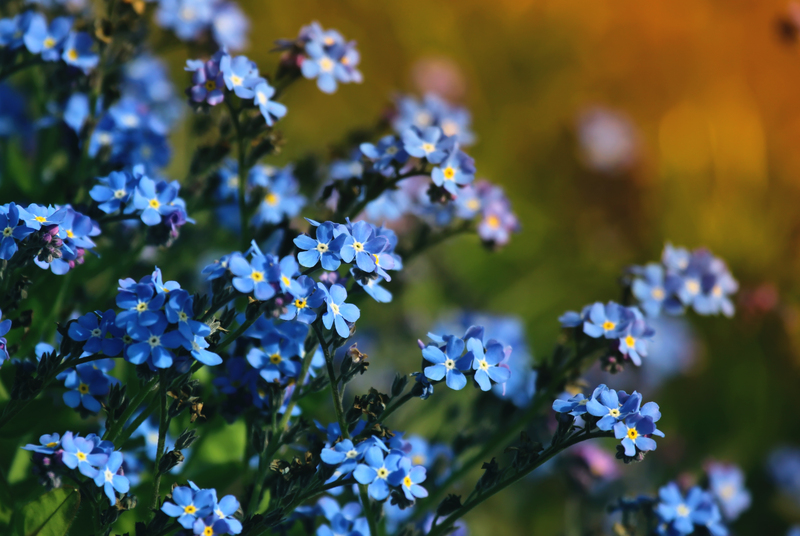Zen Garden Designs for a Harmonious and Peaceful Space
Posted on 15/08/2025
Zen Garden Designs for a Harmonious and Peaceful Space
Looking to create a personal oasis of calm in your backyard or even inside your home? Embracing Zen garden designs can help you cultivate a harmonious and tranquil environment where stress simply melts away. With their roots in ancient Japanese traditions, Zen gardens offer a sense of serenity that is both timeless and increasingly relevant in today's fast-paced world. In this comprehensive guide, we'll explore the principles, features, and creative variations of Zen gardens, helping you design your own space for inner peace.
What is a Zen Garden?
A Zen garden, also known as a Japanese rock garden or karesansui, is a stylized landscape that employs rocks, gravel, sand, and minimal plants to evoke the essence of nature. Unlike traditional gardens, which often focus on lush greenery or blooming flowers, Zen gardens emphasize simplicity, symbolism, and mindfulness. Every element, from raked patterns in fine gravel to carefully placed stones, fosters meditation and a deep sense of harmony.
Philosophy Behind Zen Garden Design
The design of a Zen garden is guided by core Japanese principles such as wabi-sabi (appreciation of simplicity and imperfection), ma (a sense of space or pause), and the practice of mindfulness. Zen Buddhist monks historically used these spaces as aids for meditation and contemplation, believing that mindful creation and maintenance of the garden can lead to spiritual clarity and peace.

Key Elements of Zen Garden Designs
Achieving a harmonious and peaceful Zen-inspired environment requires careful selection and arrangement of certain elements. Here are important components you'll want to consider:
1. Rocks and Stones
- Symbolism: Large rocks represent mountains, islands, or animals. Smaller stones can mimic the flow of rivers or shorelines.
- Placement: Stones are often clustered in odd numbers and arranged asymmetrically to reflect the unpredictable beauty of nature.
- Tip: Incorporate stones of varied shapes and textures for visual interest and authenticity.
2. Gravel and Sand
- Texture: Fine gravel or sand serves as the "sea," providing a blank canvas for raked patterns.
- Raking: Use rakes to create rippling patterns (simulating water) or linear strokes (conveying tranquility).
- Guide: Change the raking designs occasionally as an act of mindfulness and renewal.
3. Plants
- Minimalism: Zen gardens typically feature few plants--opt for moss, small evergreens, or ornamental grasses.
- Symbolic Choices: Bamboo (for strength), pine (longevity), and moss (serenity) are popular picks.
- Note: Avoid using flowering plants or bright colors that might disrupt the garden's calming palette.
4. Water Features
- Essence of Flow: Some Zen gardens include ponds, streams, or water basins to symbolize purity and the flow of life.
- Alternatives: If a water element isn't practical, use smooth pebbles or special stone arrangements to suggest water's movement.
- Idea: A simple bamboo water spout or stone basin can add gentle sound, promoting additional tranquility.
5. Bridges and Pathways
- Journey: Stepping stones or small bridges invite a mindful walk across the garden, enhancing the meditative experience.
- Materials: Use natural wood or stone for authenticity and harmony with your Zen design.
6. Lanterns and Ornaments
- Atmosphere: Stone lanterns, pagodas, or minimal statues add spiritual depth and visual intrigue.
- Balance: Use ornaments sparingly--Zen garden design favors restraint over abundance.
Principles for a Balanced and Peaceful Zen Space
To maximize the calming effect of your Zen garden design, integrate these foundational principles:
- Simplicity: Keep the layout uncluttered; each element should have purpose and meaning.
- Balance: Create visual harmony by distributing rocks, plants, and features in asymmetrical yet intentional arrangements.
- Naturalness: Favor organic shapes and weathered textures. Avoid straight lines, artificial materials, and excessive ornamentation.
- Tranquility: Choose a muted color palette and focus on the interplay of shades of green, grey, white, and earthy tones.
- Space: Incorporate "empty" spaces--areas of unbroken gravel or sand--that encourage contemplation and reflection.
Types of Zen Garden Designs
There's no single formula for creating a Zen garden--adapt your approach to the space you have and your personal journey toward peace. Below are the most popular design variations for harmonious Zen gardens:
Karesansui (Dry Landscape) Zen Gardens
This classic style--often referred to simply as the Zen rock garden--is famous for its use of rocks, gravel, and sand. Plants are minimal or absent, allowing textures and shapes to evoke landscapes such as mountains, islands, or waves. The world-famous Ryoan-ji Temple garden in Kyoto is a prime example of this type.
Tsuboniwa (Courtyard Zen Gardens)
These compact Zen-inspired gardens are perfect for urban homes or small patios. They typically integrate stepping stones, moss, and a handful of carefully chosen rocks, often with a simple water feature or lantern for added interest. Their diminutive scale encourages close, meditative observation.
Chaniwa (Tea Gardens)
Chaniwa gardens blend Zen aesthetics with the traditional Japanese tea ceremony's focus on hospitality and mindfulness. Pathways of stepping stones, lush ferns, water basins, and bamboo fences guide guests to a tea house--a peaceful journey that reflects the inner progression toward tranquility.
Modern Zen Gardens
Contemporary Zen garden designs often mix traditional principles with new materials or minimalist architecture. For instance, concrete pavers, steel edging, and sparse ornamental grasses placed in geometric patterns can evoke a Zen mood while suiting modern homes.
Step-by-Step Guide: Creating Your Own Zen Garden
Ready to craft your tranquil escape? Here are the core steps for designing a Zen garden in your outdoor or even indoor space:
1. Choose Your Location
Select a quiet spot, ideally away from heavy foot traffic. Both outdoor corners and indoor nooks can become peaceful retreats with proper planning.
2. Plan Your Layout
- Sketch your garden: Map out where you'll place rocks, sand, plants, or ornaments. Consider natural views and sunlight.
- Set boundaries: Use wooden frames, stone borders, or low hedges to define your space.
3. Gather Materials
- Rocks or boulders
- Fine gravel or white sand
- Minimal plants like moss, dwarf bamboo, or evergreens
- Optional: lanterns, water basin, stepping stones
4. Arrange the Key Elements
- Lay gravel or sand: Spread it evenly and smooth for your base layer.
- Place rocks thoughtfully: Group in odd numbers, vary sizes and textures, and tilt or partially bury for a natural effect.
- Add plants sparingly: Tuck moss around stones or add a small clump of bamboo for color.
- Install ornaments: Place lanterns, pagodas, or a water feature in discrete corners.
5. Rake and Maintain
- Use a bamboo or metal rake to create wave or ripple patterns in the gravel or sand.
- Regularly remove debris and prune plants to keep the space orderly and peaceful.
Inspiring Ideas for Your Zen Garden Design
- Mini Zen Tabletop Gardens: If you lack outdoor space, create a small desktop Zen garden with a shallow tray, fine sand, a few pebbles, and a miniature rake. Use it during breaks for instant calm.
- Zen Pathways: Line a garden path with smooth river stones and bamboo borders. Incorporate deliberate gaps or changes in direction to slow your pace, encouraging mindfulness.
- Vertical Zen Garden Walls: Mount moss or fern panels on a wall, interspersed with stone or minimalist wooden shelves for an innovative take on Zen tranquility indoors.
- Bonsai as a Focal Point: Position a well-tended bonsai at the center or edge of your garden as a living reminder of patience and care.
- Zen Combining Water and Stone: Place a stone water basin with a bamboo spout among gravel "rivers" to blend sound and sight for ultimate relaxation.
Maintaining a Harmonious Zen Garden
The peaceful essence of a Zen garden comes not only from its design but from the ongoing act of care and attention. Here are simple practices to keep your Zen garden layout harmonious:
- Regular Raking: Smooth and reshape gravel or sand to keep energy fresh and inviting. This process itself is meditative and fulfilling.
- Weed and Prune: Remove stray plants and trim moss or bamboo to prevent overgrowth.
- Seasonal Refresh: Consider subtly rearranging elements, swapping rocks, or even changing raked patterns to align with the seasons or your own personal growth.
The Benefits of Zen Garden Spaces
Investing time and thought into a harmonious Zen garden design offers more than visual pleasure. Here are key advantages:
- Reduced Stress: Immersing yourself in a calm, minimalist environment helps to soothe the mind and decrease anxiety.
- Mindfulness Practice: Raking patterns, arranging stones, or simply observing your garden encourages presence and mindful awareness.
- Enhanced Creativity and Focus: A peaceful garden provides a break from screens and busy schedules, sharpening your mental clarity.
- Environmental Connection: Engaging with natural elements, even symbolically, helps rekindle your bond with the natural world.
- Timeless Beauty: The simplicity and elegance of Zen garden design transcends trends, ensuring your garden remains beautiful and relevant for years.

Frequently Asked Questions About Zen Gardens
Can Zen gardens be created indoors?
Yes! Indoor Zen gardens are increasingly popular. As long as you have good lighting and adequate drainage (if adding plants), you can enjoy the tranquility of sand, rocks, and minimalist decor in any space, from bedrooms to office corners.
What materials are best for an affordable Zen garden?
Local river stones, play sand, reclaimed wood, and repurposed containers can help you craft a beautiful and inexpensive Zen-inspired garden. Minimal plants like mosses are low-cost and low-maintenance.
How often should I maintain my Zen garden?
A few minutes a week will keep your garden looking pristine. Rake patterns as needed, remove debris, and prune any overgrown plants to maintain harmony.
Conclusion: Embrace Zen for Your Perfect Peaceful Space
In a busy and connected world, designing a Zen garden--no matter the size--offers a vital sanctuary for relaxation, meditation, and mindfulness. By following centuries-old principles of simplicity and balance, you'll enjoy a harmonious and peaceful space that nurtures your soul and enhances your home's natural beauty. Whether you choose a classic karesansui garden or a modern Zen-inspired retreat, be guided by authenticity, care, and an open heart--and your garden will reward you for years to come.
For further inspiration, explore renowned Japanese temple gardens, or visit your local botanical garden for fresh ideas. Embark on your journey toward Zen harmony today--peace is just a stone's throw away.

